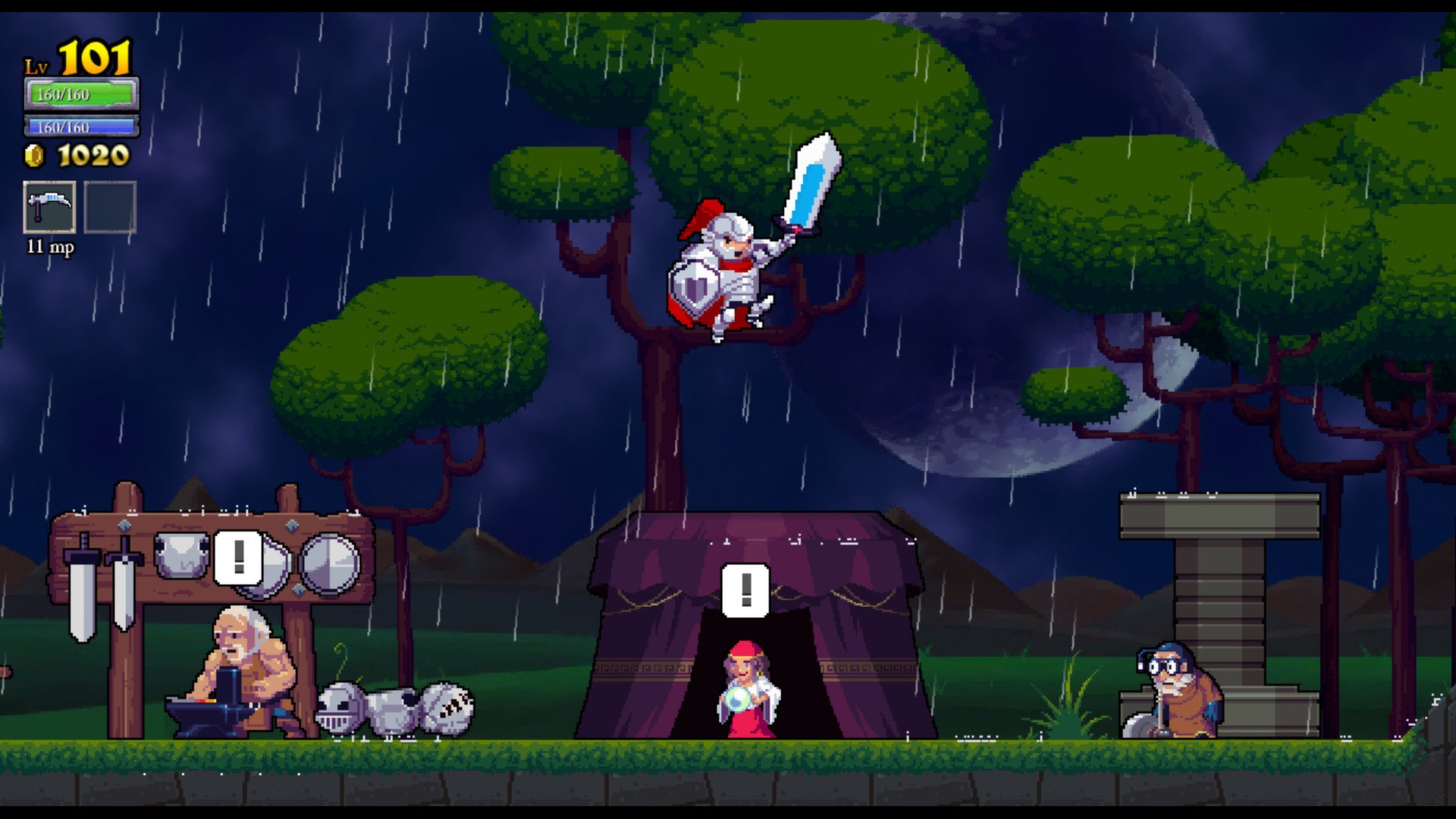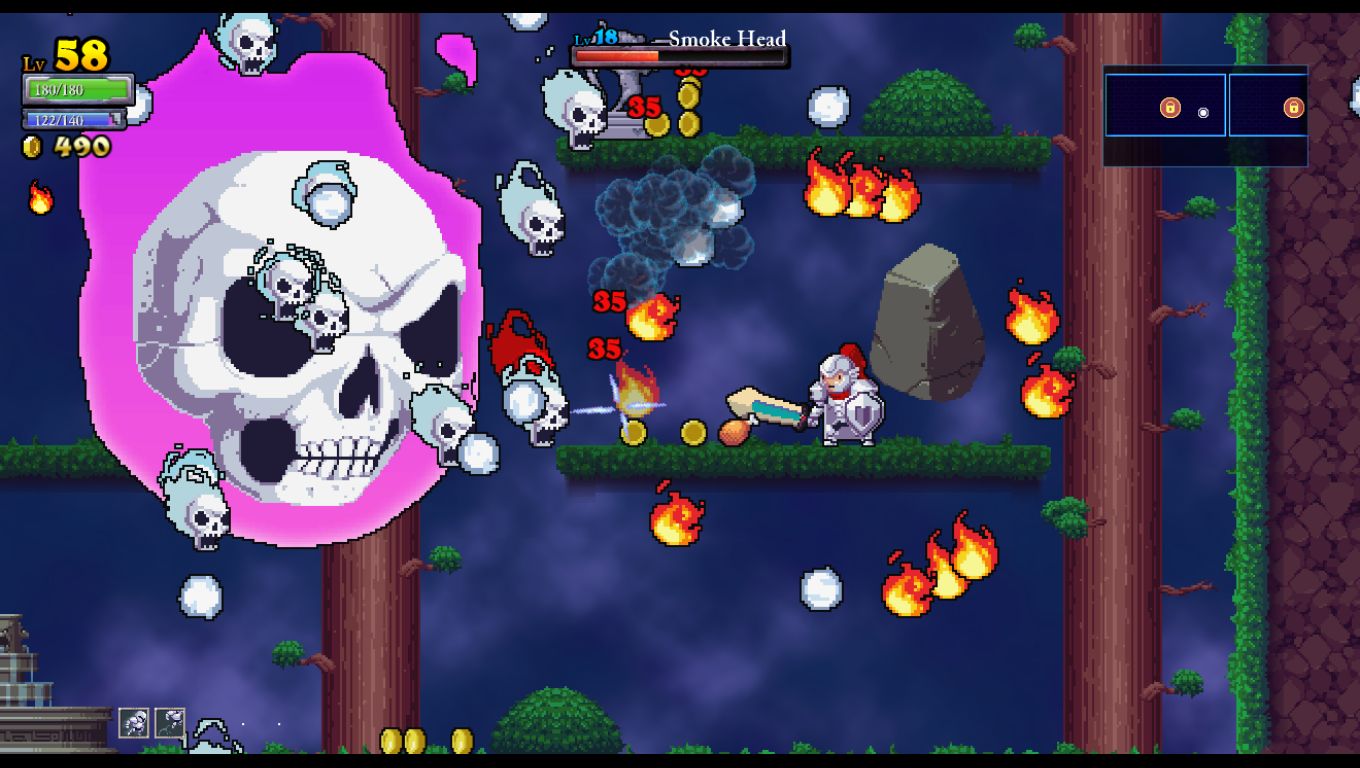Search
[{{{type}}}] {{{reason}}}
{{/data.error.root_cause}}{{{_source.title}}} {{#_source.showPrice}} {{{_source.displayPrice}}} {{/_source.showPrice}}
{{#_source.showLink}} {{/_source.showLink}} {{#_source.showDate}}{{{_source.displayDate}}}
{{/_source.showDate}}{{{_source.description}}}
{{#_source.additionalInfo}}{{#_source.additionalFields}} {{#title}} {{{label}}}: {{{title}}} {{/title}} {{/_source.additionalFields}}
{{/_source.additionalInfo}}- Details
- Category: Computer
- By ChanBearBeast
- Hits: 10579
Rogue Legacy (PC)

Rogue Legacy
Developed By: Cellar Door Games
Publisher: Cellar Door Games
Released: June 27, 2013
Available On: PC
Genre: Action, RPG, Indie, Platformer
ESRB: N/A
Number of Players: 1 offline
Price: $14.99
Rogue Legacy is a polished indie title that does its best to kill you. Whether it’s a floating eye shooting tears of blood or a spikey floor, everything does plenty of damage and death is only a careless step away. The reason why this is bearable is twofold: every death feels fair and permanent progress can be made with each life. While not for the casual gamer, Rogue Legacy gives players looking for a challenge exactly what they’re looking for.
Rogue Legacy is quickly summed up as a procedurally generated 2D Castlevania-esque game with permadeath. Every time you begin the game, you start as a descendant of a deceased previous hero. Each new hero is differentiated by class and various traits that further define them. Classes include beefy barbarians, high-damage hokages (a ninja-like class), and physically weak mages. While each class has a special ability and wildly varying stats, the gameplay felt roughly the same because all classes start with the same sword and will have a random magic attack. Traits, on the other hand, are usually superficial differences that often have an annoying or humorous effect on gameplay. Color blind will make everything monochrome, endomorph will make the hero larger and resistant to knockback, and Near-sighted will make everything blurry except the area close to the hero (this is a particularly annoying effect).
Once you select your quirky hero from the three children that the previous, deceased hero bore, you begin your quest to defeat the monsters of the same castle your ancestors failed to destroy. Due to magic or some other mystical reason, the castle reconfigures every time you die and is mostly random in its layout. The main aspects that remain the same, however, are the locations of the differently themed zones. You always begin in the Castle zone and this is the easiest of the four. The right side of the Castle is the Forest, the top has the Tower, and the bottom has the Darkness. The different zones have progressively tougher enemies and themed objects. Unfortunately many of the enemies are re-skinned versions of older enemies that have more powerful attacks. For example, a floating eyeball will shoot only one blood tear at you in the Castle zone, but will shoot five in the Darkness. Each of the zones has a boss that is an especially large version of a monster you have already encountered. These are really tough bosses that require your characters to be well equipped and well upgraded. Once those bosses are defeated, the final fifth boss is revealed.

Strong Points: Addicting Castlevania-like gameplay; high replayability
Weak Points: Repetitive when grinding to beat the next boss
Moral Warnings: Characters can be gay, mild bathroom humor
Thankfully, when you die in Rogue Legacy, you can use the money you collected in your previous life to upgrade a family castle that bestows permanent upgrades to your children. These upgrades can be simple health boosts or new abilities for the different classes. Additionally, armor and runes can be purchased and used to upgrade your character. Runes, in particular, are a clever addition that allow you to gain health from enemies or jump in the air. Overall, the gameplay was very enjoyable, but was repetitive if I had to grind for money to be upgraded enough to beat a boss.
The graphics in Rogue Legacy are well-drawn pixel art that does a serviceable, but unmemorable job at conveying the action. The characters, regardless of class, look roughly the same and many enemy types are reused in the different zones. While this helps with learning the capabilities of enemies, it becomes obvious after many playthroughs that more types would have greatly benefited the game. The sound is also standard, but some of the music tracks are grating after dozens of replays. Controls in this game are very fluid and responsive. The game, in my experience, was stable and I did not experience any crashes.

Higher is better
(10/10 is perfect)
Game Score - 82%
Gameplay - 19/20
Graphics - 6/10
Sound - 6/10
Stability - 5/5
Controls - 5/5
Morality Score - 68%
Violence - 6.5/10
Language - 7.5/10
Sexual Content - 6/10
Occult/Supernatural - 6.5/10
Cultural/Moral/Ethical - 7.5/10
The questionable content in this game is pretty limited. Enemies can be killed, but vanish in a puff of smoke. The disembodied, bloodshot eyeball creatures shoot blood-like projectiles. Finally, one of the character traits is gay and this only impacts which statue gives a chicken leg (health) or mana potion when destroyed. Other traits that are slightly questionable is I.B.S (makes your character fart during random jumps) and Coprolalia (makes your character say “%#&@!” when they are hit, suggesting that your character is cussing).
Since the content of the game is mild and the gameplay is extremely addictive, I would recommend this game to most gamers who love the stress of permadeath and classic Castlevania-like gameplay.








